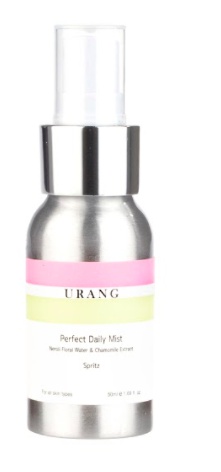
Highlights
Key Ingredients
Skim through
URANG Everyday Ph Balancing MistIngredients explained
It's the flower water coming from the flowers of bitter orange (which is the sister of the sweet orange we all know and eat). In general, flower waters (also called hydrosols) are diluted versions of essential oils coming from the same plant. They contain the same components but in far less of a concentration.
So - similar to its essential oil big sister - orange flower water contains a lot of fragrant components and has a nice, sweet scent. It has some skin toning properties and can help to relax the body.
If your skin is super sensitive, it's a good idea to choose products without fragrant floral waters.
Good old water, aka H2O. The most common skincare ingredient of all. You can usually find it right in the very first spot of the ingredient list, meaning it’s the biggest thing out of all the stuff that makes up the product.
It’s mainly a solvent for ingredients that do not like to dissolve in oils but rather in water.
Once inside the skin, it hydrates, but not from the outside - putting pure water on the skin (hello long baths!) is drying.
One more thing: the water used in cosmetics is purified and deionized (it means that almost all of the mineral ions inside it is removed). Like this, the products can stay more stable over time.

- A natural moisturizer that’s also in our skin
- A super common, safe, effective and cheap molecule used for more than 50 years
- Not only a simple moisturizer but knows much more: keeps the skin lipids between our skin cells in a healthy (liquid crystal) state, protects against irritation, helps to restore barrier
- Effective from as low as 3% with even more benefits for dry skin at higher concentrations up to 20-40%
- High-glycerin moisturizers are awesome for treating severely dry skin
A sugar beet-derived amino acid derivative with nice skin protection and moisturization properties. Betaine's special thing is being an osmolyte, a molecule that helps to control cell-water balance. It is also a natural osmoprotectant, meaning that it attracts water away from the protein surface and thus protects them from denaturation and increases their thermodynamic stability.
It also gives sensorial benefits to the formula and when used in cleansers, it helps to make them milder and gentler.
If you are into Japanese cuisine, you might know this guy as Japanese pepper or Sanshō pepper that is known for its unique fresh aroma and appetite increasing spicy sensation.
As for the skin benefits of Zanthoxylum Piperitum, it might have antioxidant effects (with active components called hyperoside and quercitrin), but more importantly, it is an antibacterial and natural preservative agent. It is pretty common in K-Beauty products, as it's one of the three natural extracts that make up the popular Korean preservative called EURO-NApre.
Combined with Usnea Barbata and Pulsatilla Koreana, these three extracts are claimed to form a natural preservative system that also has anti-inflammatory effects and might help with skin conditions such as blemishes, atopic dermatitis, and dandruff.
On the flip side, Zanthoxylum Piperitum contains fragrant components (Limonene and Citrone), that might irritate sensitive skin.
The extract of Korean Pasque Flower that is mostly used for its antimicrobial and natural preservative activities. It usually comes to the formula combined with Zanthoxylum Piperitum and Usnea Barbata, as the three extracts make up a popular Korean natural preservative system trade named EURO-NApre.
The plant extract is also a traditional oriental herbal medicine that is known for its analgesic, anti-inflammatory, and astringent effects.
The extract coming from the alpine lichen, Usnea Barbata. It is known for its excellent efficacy against gram-positive bacteria, meaning that it can serve as a natural preservative and deodorant agent.
Its main biologically active component is usnic acid (a molecule produced only by lichens) that's not only an antibacterial agent, but also has antioxidant, anti-inflammatory and wound-healing promoting effects. According to manufacturer info, the antibacterial activity of Usnea Barbata makes the ingredient helpful against body odor, blemished skin, and dandruff.
It is also very common in K-Beauty products, as it is part of a popular Korean natural preservative system trade named EURO-Napre (combined with Zanthoxylum Piperitum and Pulsatilla Koreana).
You may also want to take a look at...
| what‑it‑does | solvent |
| what‑it‑does | skin-identical ingredient | moisturizer/humectant |
| irritancy, com. | 0, 0 |
| what‑it‑does | moisturizer/humectant |
| what‑it‑does | antioxidant | antimicrobial/antibacterial | preservative |
| what‑it‑does | antimicrobial/antibacterial | preservative |
| what‑it‑does | preservative | antimicrobial/antibacterial |





